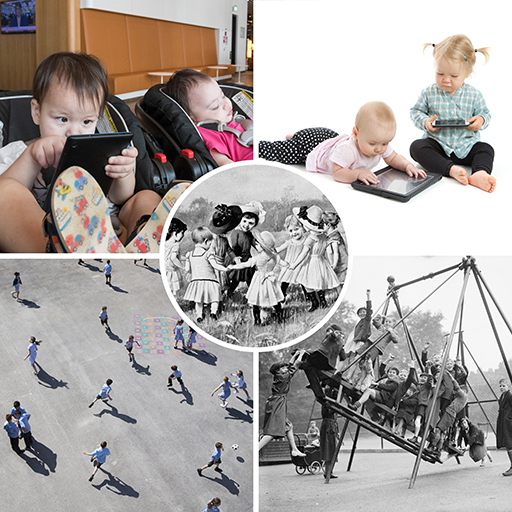Week 1: The growth and physical development of young children
Introduction
To begin, study Figure 1 and then consider the following statements:
- Technology is the best source of children’s learning
- Children move less than those of previous generations
- Children have less freedom now to play and explore.
What were your immediate thoughts about the photographs and statements?
The world children inhabit has changed significantly in the last 40 years. Spaces to play in are often limited and worries about their safety mean they don’t have opportunities enjoyed by previous generations to play freely.
The education system in England is also demanding and there is a focus on teaching specific aspects of the curriculum such as maths and English that require them to sit still for long periods and not move about.
Technology has undoubtedly affected children’s play choices; babies and children are given access to digital toys and other devices which means that many are spending increasing amounts of time using a screen which is very likely to impact on their motivation to be physically active.
All these factors are affecting children’s physical growth and development as well as the quality and amount of physical activity they are taking part in. In short, many children are not moving enough to properly support their overall health and wellbeing and ensure smooth growth and physical development.
Adults tend to take young children’s growth and physical development for granted – meaning that, given a supportive environment, good food, enough sleep and appropriate opportunities to be physically active it will ‘just happen anyway.’
In many ways this is true: they visibly grow taller and weigh more over time; baby or ‘milk’ teeth fall out and permanent teeth appear; hair and nails grow and need cutting; clothes and shoes require continual replacement; and they become physically more confident, competent, creative and adaptive. But children now need much more support from the adults in their lives to ensure that their growth and development is encouraged, and they are given plenty of varied opportunities to be physically active.
This is what this course is really about. Each week you will learn more about how children’s physical development, health and wellbeing are linked, and how you can best support children to move more so their life chances are maximised, and they reach their full potential.
By the end of this week, you will be able to:
- describe the relationship between young children’s growth and their physical development
- identify the factors that may support or compromise children’s growth and physical development
- identify the available mechanisms and personnel that can support children’s growth and physical development.
In this course you will see the words growth and development used throughout. These two terms are defined in the following ways:
- Growth is the progressive increase in the size of the child – or parts of the child.
- Development is the progression towards maturity and the progressive increase of various skills and abilities.

